Cotton
Cotton was traditionally the single largest natural fibre used in clothing. Today India occupies the second position in cotton production in the world. Many varieties of cotton were produced in our country, the majority being the short staple variety which is ideal for hand spinning. We have moved away from growing short staple varieties but still produce good amounts of cotton both for domestic use and for export. Heavy use of pesticide has led to many problems and now there is a shift to organic farming.
Over 500 indigenous varieties of cotton were grown in India in the past. Today, we grow less than 20 varieties.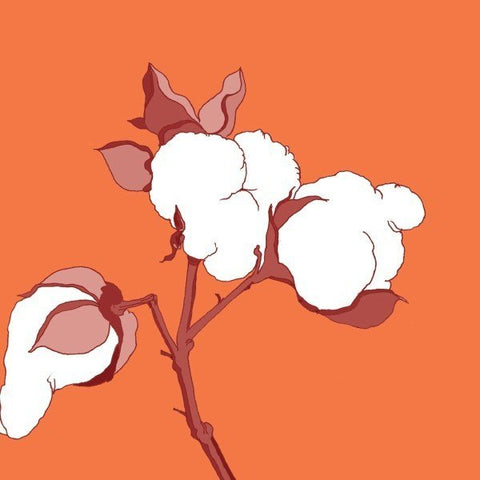
Yarn
Yarn is a long continuous length of interlocked fibers. Staple length of cotton determines the thickness of yarn spun and this is referred to as “yarn count”. Standard measure for a length of cotton yarn is “hank”. A hank measures 840 yards. Hank yarn is used typically in handloom production as opposed to cone yarn which is used in mill production.
Hank yarn is available from a coarse 2’s count to a fine 120’s count based on the fiber length of cotton.
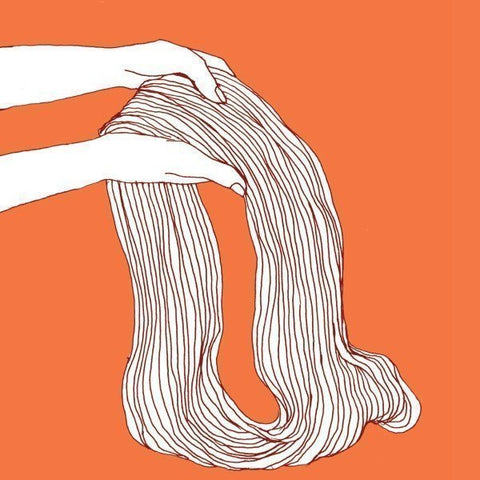
Spinning
Spinning is the process of converting textile fibers and filaments into yarn. For thousands of years, people spun natural fibers into yarn by hand. Today, spinning involves many methods and different machines, depending on what kind of yarn is being made. Handloom weaving uses two kinds of yarn, one is hand spun yarn and the other is mill spun yarn.
Even today, handloom industry mostly uses natural fibers like cotton, wool and silk.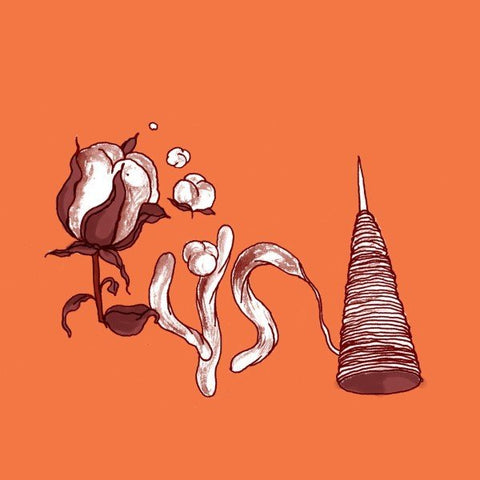
Hand Spinning
The process of converting cotton fibre to yarn is complex and the strength and fineness of yarn is dependent on the staple length of the fibre and the skill of the spinner. Yarn can be hand spun in two ways – cotton fibre to yarn by hand, cotton to sliver by mechanical process which is then spun by hand in various thicknesses. Srikakulam in north coastal Andhra remains the only hand spinning belt in the country, where fine yarn upto 100s count is spun.
Yarn is less stressed in hand spinning process. Hand spinning wages increases the cost of Khadi.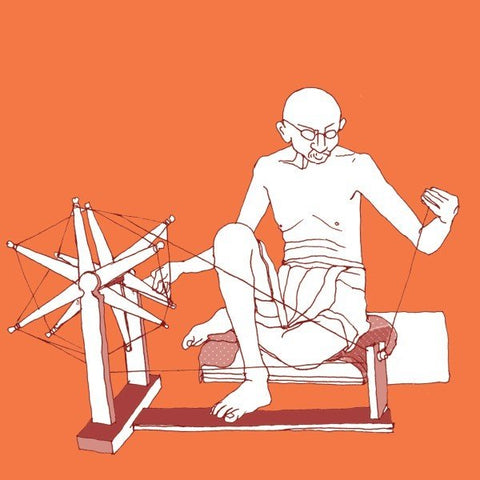
Mill Spinning
Mechanical spinning of yarn in the West began with the industrial revolution in the 17th century. During colonial rule, the British introduced mill spinning in our country. Large spinning mills were initially located in Mumbai and later most of the activity shifted to Tamilnadu and a few pockets in Andhra Pradesh. Today mill spun yarn is used extensively by handloom weavers across the country.
The Bombay Spinning & Weaving Mill at Tardeo, Mumbai, was one of the first mills set up in India in 1854 to supply yarn to local handloom weavers.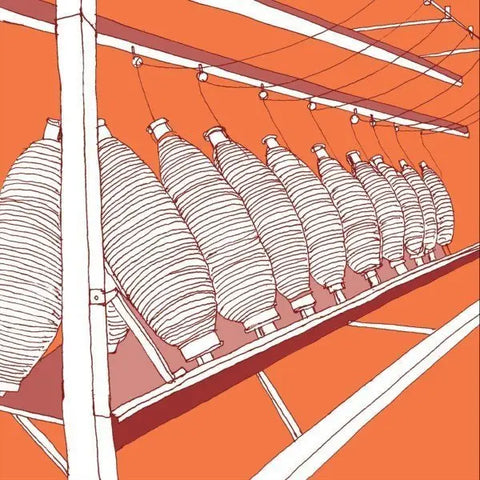
Dyeing
Textiles can be dyed in the yarn form or at the fabric and garment stages. Hank yarn dyeing is a predominant practice in South India unlike in the North where fabric is dyed for developing prints in the craft sector. The dyeing process involves “scouring” to remove natural oils and dirt present in cotton after which natural or chemical dyes are used for colouring. Dyeing for handloom is done in and around weaving villages by local experts.
In the past, sarees had very little colour in them. Colour was used mainly in the borders and pallu.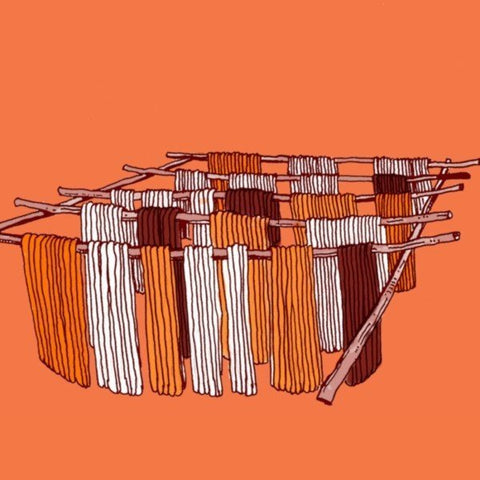
Chemical Dyeing
The discovery of the structure of benzene in 1865 in Europe heralded the shift from natural dyes to chemical dyes. Chemical dyes – direct dyes, sulphur dyes, napthol dyes, vat dyes and reactive dyes – that are used today were developed during the period 1878–1956. They offered a wide range of colours with an ease of application along with the properties of fastness that suited modern-day usage.
Chemical dyes replaced local natural dyes many decades back. Today chemical dyes are available in different varieties. There are categories of dye stuff in chemical dyes which are azo free. Azo free dyes are environment friendly and do not harm the environment, dyer and user. Chemical dyes were initially invented to suit large centralized mill production base. These dyes were adapted by the local weavers to dye their yarn in colours.
The series of pictures show the dyeing of red colour by a weaver couple in Nalgonda district. Ikat weavers are the only weavers who still do their own dyeing. Otherwise dyeing is carried out by people trained in dyeing.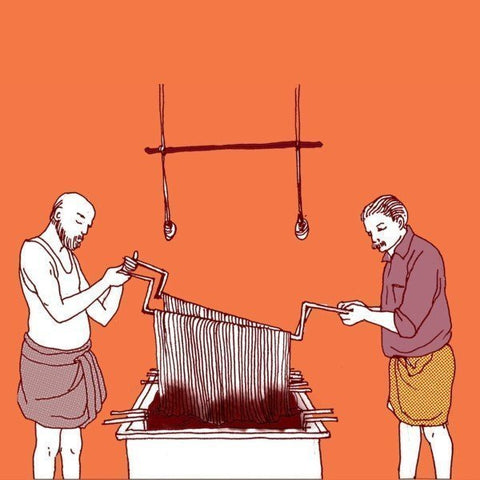
Natural Dyeing
Dyes extracted from natural materials such as the bark of trees, flowers, leaves and minerals are known as natural dyes. Vegetable dyes are a sub-category of natural dyes, referring to colours that come from plant matter only. Mordants, which are usually minerals, are used to fix dyes on cotton. All natural dyes generally yield lasting colour though some colours are sensitive to sunlight.
Natural dyes are extracted from natural materials such as bark of trees, flowers, leaves and minerals. Natural dyes were used traditionally by weavers across the country. Chemical dyes completely replaced natural dyes sixty years back.
Vegetable dyes are a sub-category of natural dyes referring to those that come from plant matter only. Wool is generally the best fiber to color with natural dyes. It will attach to a wider variety of dye chemicals than cellulose fibers such as cotton, and, since it is usually washed in cool water, or only dry-cleaned, colour fastness of natural dyes does not become a big issue.
Cotton is less suitable for many natural dyes. There are some natural dyes that will work on cotton especially if mordanted with tannins. Among the better natural dyes for cotton are annato, cutch, logwood, madder, and indigo. All of these except for indigo require mordants, while indigo requires a special type of dye vat.
The series of pictures show anar, pomegranate rind dyeing process.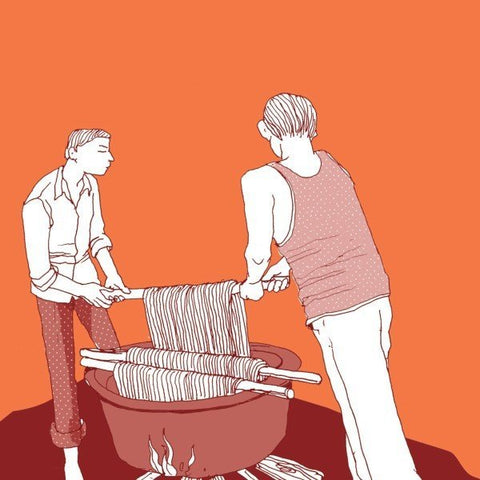
Indigo Dyeing
Indigo dyeing was one of the first specialty professions in manufacturing of textiles. Indigo dye is derived from the plant Indigofera tinctoria. It contains neither harsh chemicals nor toxic metals. It can be used to dye any natural fibre. Cotton yarn dyeing in indigo is done across some parts of Asia & Africa. The use of indigo dyeing goes back to 2000B.C.
Indigo is a dye different than any other and is best known for the brilliant blue colour among natural dyes. Traditional indigo dyeing is a long and involved process of dyeing carried out in vats. First step in the process “reduces” the indigo, changing it from blue to yellow. When the yarn is worked in the solution, or “vat” and brought out to the air, it is a bright green. Slowly the air changes it to the beautiful deep and rich blue of Indigo. Indigo in some form was used in all traditional cultures, for it is the only clear and fast natural blue.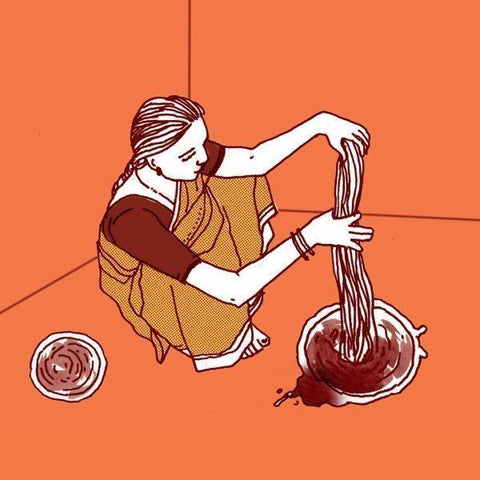
Bobbin Winding
Yarn in the hank form is wound on bobbins in this process. This is the first step in transforming the yarn from the hank form to a linear form. Dyed hank yarn is wound on bobbins with the help of charkas. This process enables the laying out of yarn lengths for weaving. Bobbin winding is done by women in the weaver households.
Typically 19 to 20 bobbins are required for a five saree “warp” length of 34 meters.
Bobbin winding is one of the important pre-loom processes which enables the laying out of yarn lengths for weaving. Each hank is wound onto a bobbin and the yarn on each bobbin is fed to the warping drum to form the warp on the loom. Bobbin winding is done by women in the weaver households.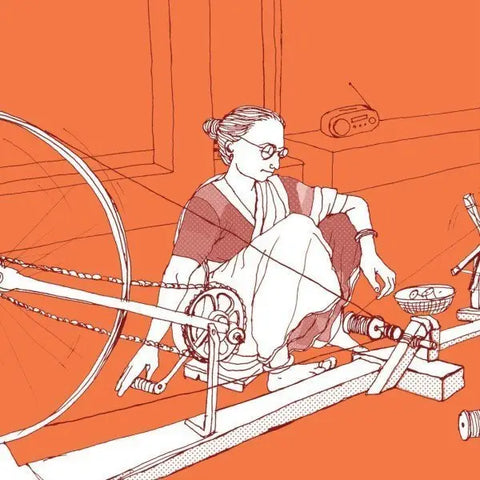
Warping
The warp is a set of threads attached to the loom lengthwise before weaving begins. Warping is the process of creating the base yarn that runs along the length of fabric through which the “weft” yarns are filled in to make the fabric. For a 46-inch wide fabric, over 3,200 individual yarns run along the warp of the fabric. Typically, 1,96,550 yards of yarn are aligned by wrapping them around the circular warping drum.
Traditionally warp lengths and widths varied according to the draping styles of the sarees of a particular region.
Warping is a process, which converts the hank yarn into a linear form to give the length on the loom. Warping is done on a huge drum and the width and desired quality of the product is decided at this stage. The drum also helps to calculate number of threads and the length of the warp.
The series of pictures show drum warping done in a village in East Godavari.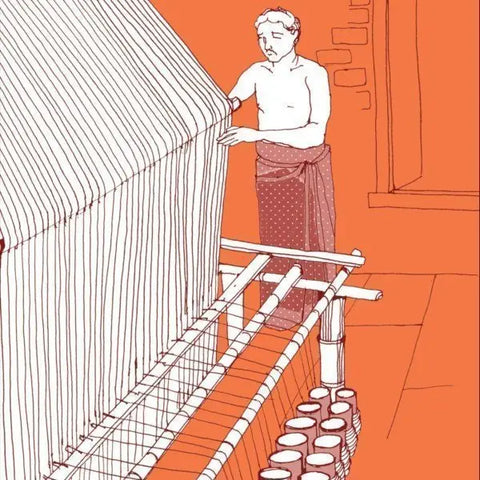
Street Sizing
The warps are stretched out on two beams and natural adhesives are applied to add strength to the yarn and lubricate it to withstand the rigors of weaving. In most handloom centers, rice starch/gruel is mixed with coconut/groundnut oil and applied as “size” material. Sizing is carried out by weavers or specialists in the village. Since this activity is done on the street, it is called “street sizing”.
The brush that is used in the sizing process is made locally using available natural material like palmyra fibre.
Sizing is a pre loom process, which is unique to handloom weaving. Sizing is done to give temporary strength to single count cotton yarn to withstand the rigor of weaving while keeping the characteristics and properties of cotton yarn intact.After warping is done, the warp is stretched out and sizing material is applied to add strength and lubricate the yarn. Natural adhesives like rice, maize, wheat flour or potato starch are used depending upon the availability and region. In most handloom centers rice starch / gruel is mixed with coconut / groundnut oil and applied as sizing material. This activity of starching the yarn for weaving is known as “sizing”. This starch in the yarn is removed only after two to three washes of the woven product.
Sizing is either carried out by the weavers or by skilled groups in the village. Typically, depending on the warp length, three to four persons are required to carry out sizing. After application of the sizing paste onto the stretched yarn, special brushes are used to spread and dry the starch on the yarn. Since this activity is carried out on the street, this is referred to as “street sizing”.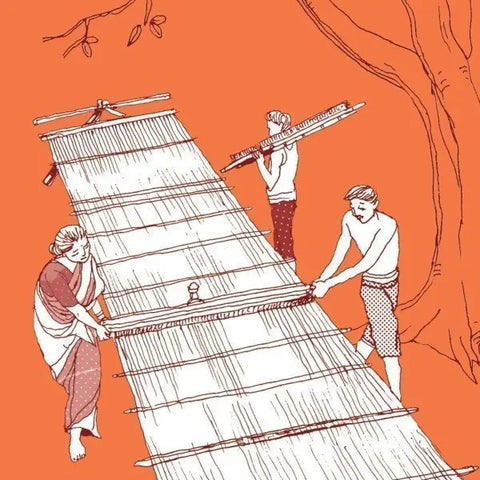
Attaching Warp onto the Loom
Individual warp threads are drawn through heddles taken through a set of reeds and tied on beams located on both ends of the loom. The heddles separate the warp into two sections which allows the weft threads to pass between them. Checks and stripes are created by segmenting the warp and weft yarn. For weaving motifs, looms are equipped with “dobby” or “jacquard” setting which help in lifting segments of warp yarn into the weft.
Women attach each single yarn to the existing yarn of the warp with help of ash.
Dressing the warp is done after sizing and before the warp is attached. This activity helps align and separate all the yarns in the length to facilitate smooth weaving.
After dressing the warp, the warp is generally attached to the ends of the existing warp. This is then pulled onto the other side of the heddles and reed.
Heddles are made out of rods or cords, each with an eye through which the warp thread is drawn.
Reed is a comb like frame that pushes the weft yarn firmly against the finished cloth after each insertion.
The series of pictures show men dressing the warp first and then women attaching the warp threads.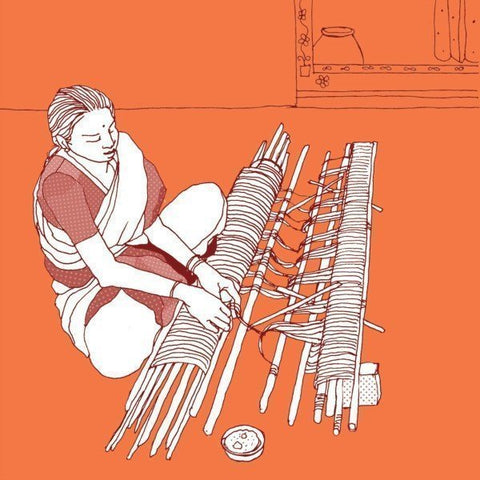
Weft Winding
Hank yarn for weft is wound on a pirn. The weft yarn is then inserted into a shuttle. Weft preparation is done on the charka, using the finger tips to give the correct tension to the yarn. This operation is normally done by women.
Pirn is a small bobbin. Shuttle is a device used in weaving to carry the weft thread back and forth between the warp threads.
Changing colours in the weft allows for the creation of “shot” colours which make the fabric lustrous and vibrant.
Weft winding is one of the processes carried out by the women in the family. Weft in a fabric is yarn which passes across the fabric width. Weft yarn is passed through the warp yarn to create the fabric structure. Weaving is highly dependent on this pre-loom activity, which is in crisis at present. One of the main reasons is women going out of the house for other livelihood options.
The series of pictures shows a woman carrying out weft winding in a village in East Godavari district.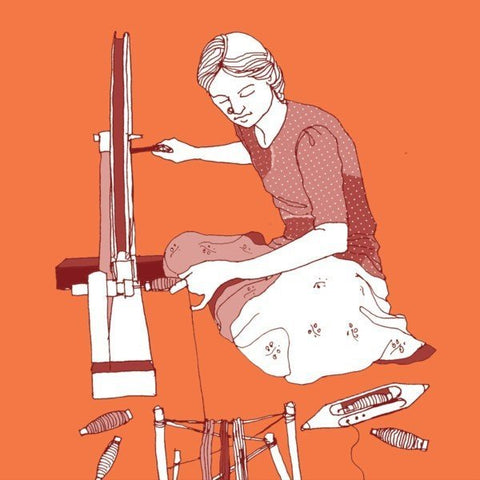
Weaving
The process of weaving is the interlacing of two sets of yarn – the warp and the weft. The equipment that facilitates this interlacement is the loom. A “handloom” is a loom that is used to weave fabrics without the use of electricity. The manipulation of the foot pedals to lift the warp has to be in sync with the throwing of the shuttle which carries the weft yarn. A perfect weave demands coordination between mind and body. The weaver achieves a harmony of motion and rhythm to create a unique product.
Depending on the complexity of design, a weaver weaves between half a meter to five meters of fabric a day.
Loom
Pit loom, stand loom and frame loom are three kinds of looms predominantly used by handloom weavers. The pit loom is a loom situated on the ground / floor with a pit having two peddles set in the pit for the weaver to operate. Pit loom weaving is considered to be better weaving as the fabric woven retains the character of the fiber and fabric due to the proximity of the loom to the ground. The ground absorbs the tension and speed and makes the fabric more breathable.
The series of pictures show weavers working / operating a pit loom.
Petu, dobby technique
Petu, an extra warp technique, which is also called dobby technique is used by weavers to create patterns in the borders of sarees and dhoties. It is one of the most popular techniques for creating patterns. The weaver sets the pattern according to the size and proportion of the design in ratio to the yarn thickness and number of yarns used in the width. The dobby set up on the loom will help the extra warp threads to be lifted automatically by the weaver while weaving.
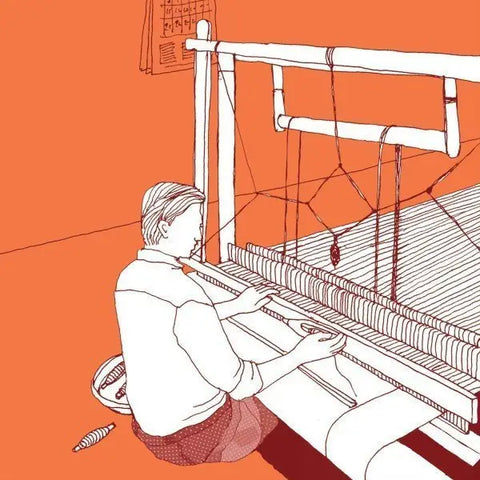
This content is originally posted in an Dastkar Andhra
Blogs you might also like:
The Great Mythological History Of Dhanteras
Chitrika Artisan Producer Company - Crafting Collective Gain
Kanchipuram Weaving
 Verified Purchase
Verified Purchase



























































































































































































Leave a comment (all fields required)